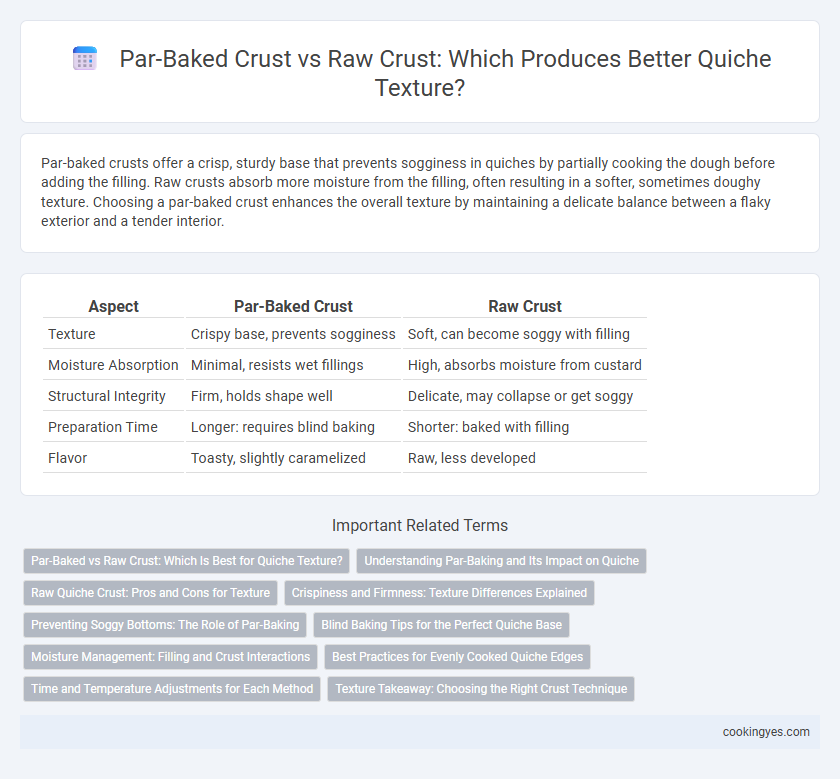Par-baked crusts offer a crisp, sturdy base that prevents sogginess in quiches by partially cooking the dough before adding the filling. Raw crusts absorb more moisture from the filling, often resulting in a softer, sometimes doughy texture. Choosing a par-baked crust enhances the overall texture by maintaining a delicate balance between a flaky exterior and a tender interior.
Table of Comparison
| Aspect | Par-Baked Crust | Raw Crust |
|---|---|---|
| Texture | Crispy base, prevents sogginess | Soft, can become soggy with filling |
| Moisture Absorption | Minimal, resists wet fillings | High, absorbs moisture from custard |
| Structural Integrity | Firm, holds shape well | Delicate, may collapse or get soggy |
| Preparation Time | Longer: requires blind baking | Shorter: baked with filling |
| Flavor | Toasty, slightly caramelized | Raw, less developed |
Par-Baked vs Raw Crust: Which Is Best for Quiche Texture?
Par-baked crust offers a crisp, sturdy base that prevents sogginess in quiches, maintaining a flaky texture after baking. Raw crust absorbs more moisture from the filling, often resulting in a softer, sometimes soggy bottom. Choosing par-baked crust enhances the overall texture by balancing a firm crust with the creamy, custard-like quiche interior.
Understanding Par-Baking and Its Impact on Quiche
Par-baking a quiche crust involves partially baking the dough before adding the filling, resulting in a crispier and more stable base that prevents sogginess caused by wet fillings. This technique helps retain a flaky texture while ensuring the crust cooks evenly and supports the creamy, custard-like filling without becoming soggy or undercooked. Using a raw crust often leads to a softer, sometimes doughy texture due to insufficient moisture barrier, making par-baking essential for achieving the ideal quiche crust texture.
Raw Quiche Crust: Pros and Cons for Texture
Raw quiche crust allows the dough to fully absorb the quiche filling's moisture, resulting in a tender and flaky texture that contrasts well with creamy egg custard. However, it can lead to a soggier bottom if the filling is too liquid or if the crust is not properly chilled before baking. Proper chilling and using high-fat butter can enhance the crust's structural integrity while preserving a delicate, melt-in-the-mouth texture.
Crispiness and Firmness: Texture Differences Explained
Par-baked crust for quiche delivers superior crispiness and firmness by setting the dough structure before adding the filling, preventing sogginess. A raw crust often absorbs moisture from the custard, resulting in a softer, less distinct texture that can compromise the quiche's overall mouthfeel. Choosing par-baked crust enhances the contrast between a flaky shell and creamy filling, optimizing sensory appeal.
Preventing Soggy Bottoms: The Role of Par-Baking
Par-baking quiche crust involves partially baking the crust before adding the filling, creating a sturdy barrier that prevents moisture absorption and sogginess. Raw crusts often lead to soggy bottoms as the custard filling seeps into the pastry during baking, compromising texture. Using a par-baked crust enhances the quiche's overall crispness and structural integrity, delivering a perfectly textured slice.
Blind Baking Tips for the Perfect Quiche Base
Using a par-baked crust for quiche ensures a crisp, golden base that prevents sogginess caused by the custard filling. Blind baking with pie weights or dried beans stabilizes the crust, avoiding shrinkage and promoting even cooking for optimal texture. For the best quiche results, bake the crust until lightly golden before adding the filling, enhancing both flavor and structure.
Moisture Management: Filling and Crust Interactions
Par-baked crusts provide a sturdier base that reduces moisture absorption from the quiche filling, maintaining a crisp and flaky texture by preventing sogginess. Raw crusts tend to absorb more moisture from the custard mixture during baking, often resulting in a softer, sometimes limp texture. Effective moisture management between the filling and crust is essential for achieving the ideal balance of a tender quiche filling with a well-structured crust.
Best Practices for Evenly Cooked Quiche Edges
Par-baking quiche crust ensures a firmer, flakier texture and prevents sogginess by setting the dough before adding the filling. Raw crust often results in uneven cooking and a softer, less structured edge due to moisture absorption from the custard. For evenly cooked quiche edges, blind bake the crust for 10-15 minutes at 375degF, then add the filling to maintain optimal texture and prevent shrinkage.
Time and Temperature Adjustments for Each Method
Par-baked crusts require shorter baking times at higher temperatures, typically 375degF for 10-15 minutes, ensuring a crisp, flaky texture without sogginess. Raw crusts need longer bake times at moderate temperatures around 350degF for 40-50 minutes to fully cook the dough while allowing the quiche filling to set properly. Adjusting time and temperature based on crust preparation optimizes the final texture, balancing a tender, golden crust with a creamy, well-cooked filling.
Texture Takeaway: Choosing the Right Crust Technique
Par-baking quiche crust creates a crisp, golden base that prevents sogginess by partially cooking the dough before adding the filling, ensuring a firm, flaky texture. Raw crust allows the dough to fully bake with the custard, resulting in a softer, more tender crust that absorbs moisture for a creamier bite. Selecting par-baked crust enhances structural integrity and crispness, while raw crust yields a moist, delicate texture, making the choice essential for desired quiche consistency.
Par-baked crust vs raw crust for quiche texture Infographic

 cookingyes.com
cookingyes.com